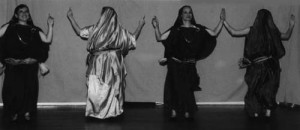First published in Habibi – 1970s
By Morocco (C.V.Dinicu)
In addition to her ongoing teaching and performing activities, Morocco has been doing week-long seminars, commuting to Europe twice a year to do seminars and concerts, leading tours to Egypt, Turkey and Morocco, and making research trips. Long-time contributor Morocco revives the debate on the historical authenticity and appropriateness of the use of floorwork in the dance.
A while ago in Habibi there was a letter from a man who said he was of Mideastern origin, and that he was disgusted by something he saw here, that he never saw where he came from, and that he considered disgusting: floorwork.
I’d like to know where he has been hiding for the past thousand years or so. I assume he is not Moroccan, or he most certainly would have known about the Guedra, a good part of which is done on the knees, Schikhatt has parts on the knees and sometimes almost flat on the back, the Ahouaches of both Imin Tanout and Pasha Glaoui have steps on the knees; part of Oriental dance (Raqs Sharqi), as done there, is on the knees and called “Danse du Scheherezade” — don’t ask me why it’s called that, I don’t know.
I am willing to believe he has never seen a Gnaoui trance dance, done almost entirely on the knees and back, since it is sacred, and never done in public. What about the tray dance, done by both sexes, wherein performers descend to the floor with a tray (and teapot and glasses) on their heads and do several steps there, to demonstrate their skill in balancing, even lying on their backs and stomachs and rolling over — slowly of course! What about the Egyptian “Raqs al Shemodan” – the fascinating Candelabrum dance, done mostly at weddings, which definitely includes “showoff” floorwork?!
He could not have been Lebanese, Syrian, or Jordanian because the reknowned Nadia Gamal worked there for 35 years before her very untimely death, and always included floorwork, as did just about every other dancer in those countries, before it became “in” to imitate or out – gimmick current Egyptian dancers and their videos.
He is not Turkish or from any of the Turkic or Central Asian countries, where Oriental dance is a part of the tradition — they do floorwork and have many other dances, where parts are done on the knees. I am not referring just to those at the lower end of the Turkish ‘Oryantal’ scene, working in some Istanbul nightclubs, who do some unbelievably vulgar floorwork, wearing costumes that make it possible to do a gynecological exam from the back of the audience.
Historical accounts by conquering Roman officers describe Iberian dancing girls, who sank, with quivering thighs, to the ground. It is a fact that during Mohamed Ali’s reign in Egypt, in order to toady up to the British imperialists filthy-minded Mid-Victorian sensibilities, he first banned floorwork and the quiver (because of its use in the notorious “dance” known as the “Bee”), then banished all dancers from Cairo for several years.
However, several accurate (versus fantasy) Orientalist paintings and lithographs exist with dancers on their knees, some with a tray or sword balanced on their heads, some without. There are descriptions of movements, done in a kneeling position, in the course of an Oriental dance, in several eye-witness accounts from Egypt, Syria, Turkey, Central Asia, Azerbaijan, etc.
King Farouk, the last of the Ottoman rulers of Egypt, was notorious for many things, among them his love of Oriental dance and dancers. After the 1952 revolution, Oriental dance was prohibited on religious grounds by a Dr. Rageb, but allowed again in 1954: they needed all those tourist dollars and the people demanded it, especially for weddings. However, certain restrictions were imposed:
- The torso had to be covered. Now you know why the net covering with its inconveniently placed zipper.
- No floorwork: 100 pound penalty for the first offense.
- No quivering (what I call “earthquake” versus the very popular rapid up and down “shimmy”) Some famous dancers can occasionally get away with doing it now.
- If somebody is taking a photo, the dancer must stand stock still. That is why some dancers use a part of their dance to go from table to table and pose for photos with the customers, or why they stop and pose if somebody comes up onstage for a photo. I have no idea what the reasoning behind that was.
If a dancer disobeyed and was caught by somebody from the Artist Licensing Ministry (Tafteesh el Feini), she would be fined, jailed, or lose her license, thereby losing her right to perform for pay in public.
The above leads me to deduce that the letter writer was possibly Egyptian, but that does not let him off my hook: part of Raqs al Shemadan (Candelabrum dance) is done on the knees, on the floor, and sometimes flat out, but the dancer gets away with it because it is considered “folklore”.
In 1979, Negwa Fouad did one of the best of her ever – changing shows, where she came out in a sedan chair, carried by two Nubian hunks, to the music of “Sitt el Hosni”. During that dance, Negwa did floorwork, lying on her side. I captured it on my #4 videotape/DVD: “Stars of Egyptian Dance — Negwa Fouad, Soheir Zaki, Aza Sherif”.
How did she get away with it? Easy: she was the biggest dance star of her time, married to the manager of all the Sheraton Hotels, and the dance was described as being that of an Odalisque of the Ottoman Turkish (Farouk) era. OK, then explain how she got away with more floorwork, in another dance later in that show . . . I loved that show . . . she also did her 40s dance-hall hooker number: “Dandasha” – a real hoot!
Forty-five years ago (!), when I started in this business, all the dancers did floorwork: Turks, Lebanese, Algerians, Assyrians, Armenians, Egyptians, Jordanians, Syrians, Moroccans, Greeks and Americans, in clubs and at family celebrations all over the U.S. and Europe, and in most clubs — except those in Egypt — that I visited or worked in throughout the Near and Middle East, North Africa, the Mediterranean, Central Asia and the Caucasus. It was considered an integral and expected part of the dance, so we did floorwork. There were standards of good taste and technique; some met them, some not, but the fact was, and remains, that floorwork is a valid, “authentic” part of an Oriental dance.
So what happened? Almost nobody does floorwork anymore. For many reasons it seems to have gone out of style:
- Some dancers think if they do not see it on a current Egyptian video, it is not “correct”, but if something is on a video from “Over There”, it is required. Does this mean we all have to make our entrances by being lowered in a basket by a cherry-picker – like Fifi Abdou? Or come out of a giant clamshell, like Mona Said? I could go for being carried in by 2 hunky guys, but a cherry-picker? . . .
- In some clubs and restaurants, the seating arrangement is such that past the first row of tables, nobody sees what you are doing and thinks you left in the middle or were sacrificed to the volcano god, so logic says cut the floorwork in those situations.
- On theater stages, only balcony seats can see and the whole orchestra section feels cheated.
- Unless the dance area is clean and smooth, you can get filthy, which can ruin your costume and look awful when you get up or worse, you could hurt yourself.
As with any other part of the dance, it is up to the dancer as to whether or not to do it. However, like the boy scouts, you should be prepared, should the desire, proper floor and audience present themselves. Learn floorwork and practice, practice, practice. At the very least, it is great for the front thigh muscles.

